Palermo Cathedral (duomo)
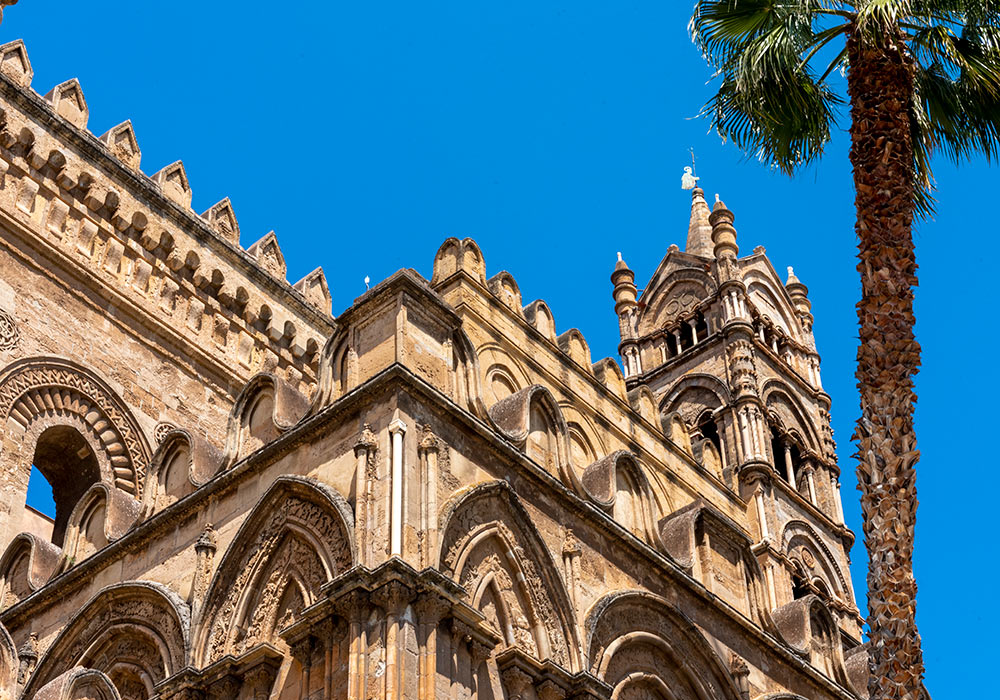
Palermo Cathedral is characterized by different architectural styles, due to a long history of additions, alterations and restorations. It was erected in 1185 by Walter Ophamil (aka Gualtiero Offamiglio / Walter of the Mill), the Anglo-Norman archbishop of Palermo and King William II's minister. The Archbishop of Palermo, Gualtiero Offamiglio’s main aim was to surpass the glory of the magnificent cathedral of Monreale: “The Battle of the Two Cathedrals”.
The majority of Norman churches in Sicily have retained their original form; however, the Cathedral of Palermo has undergone numerous transformations over time. Up to the 17th century, various elements were added to the medieval structure, both to complete unfinished sections and to align the church with evolving aesthetic preferences. During the 14th century, additional stories were constructed atop the corner bell towers. In the 16th century, a portico was added to the southern façade, and a grand marble apparatus, known as the Tribuna, was created within the main apse by A. Gagini. By the late 18th century, the cathedral underwent significant modifications as part of an extensive renovation project referred to as the Riforma, which established the form in which the cathedral is seen today.
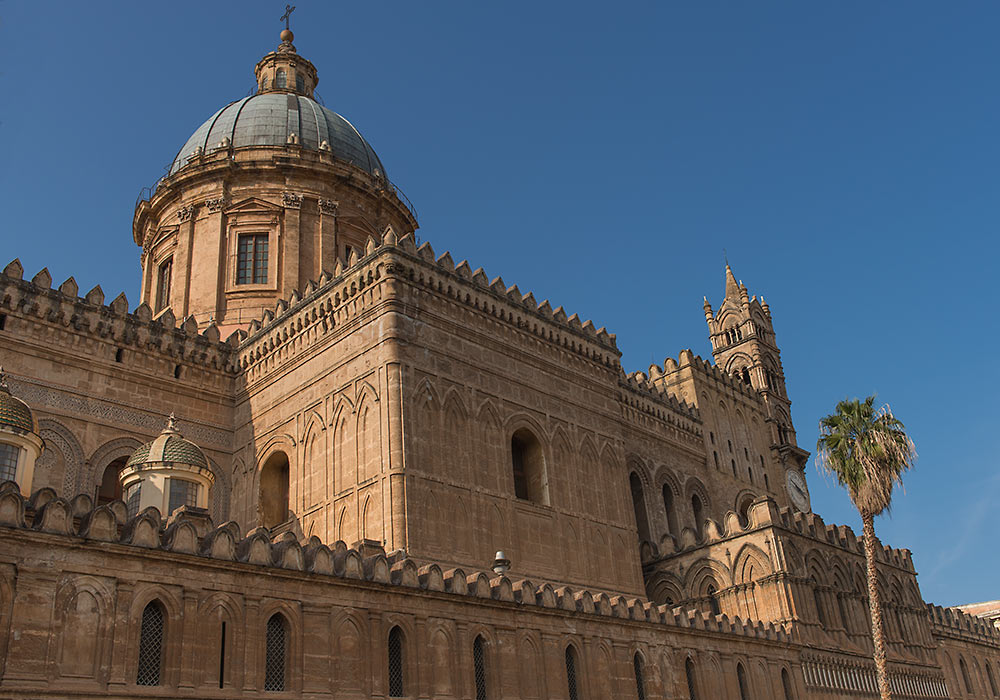
The cathedral in the center of Palermo – not to be confused with the Monreale Cathedral – was built on the site of an older basilica (used as a mosque in the 9th century).
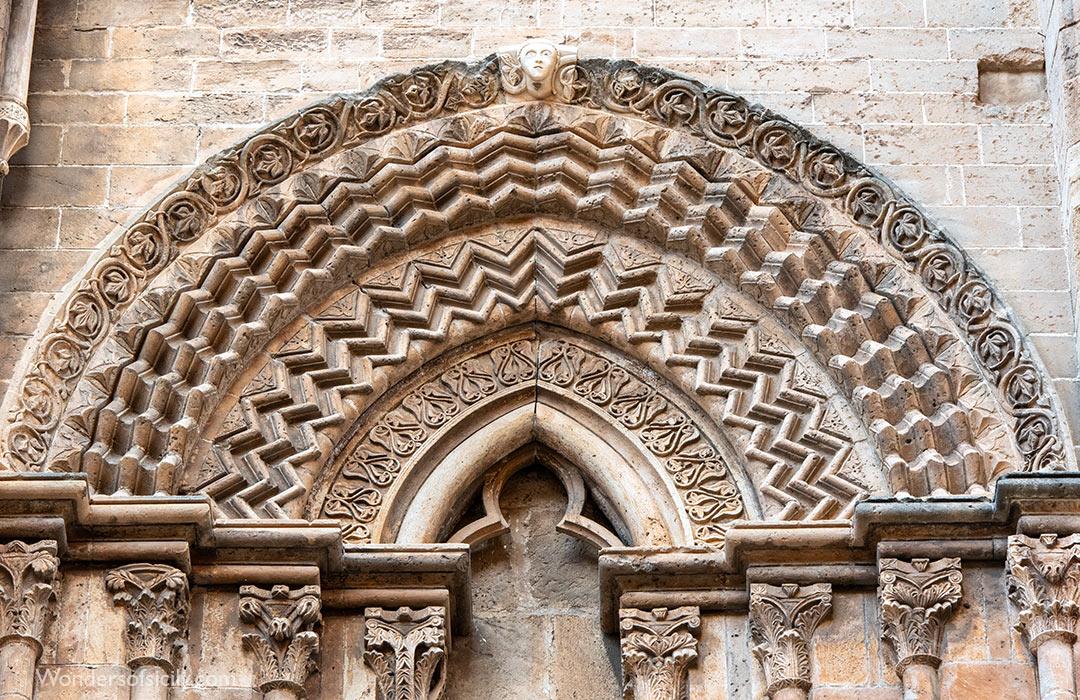
Portal.
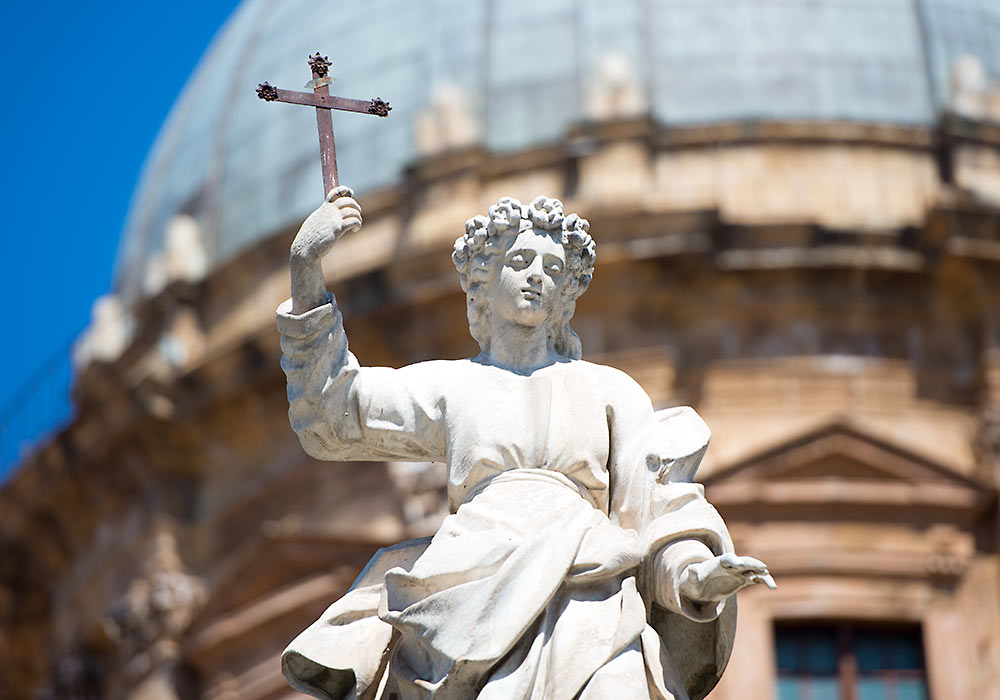
Statue of Santa Rosalia outside the cathedral in Palermo. Santa Rosalia is the patron saint of Palermo.
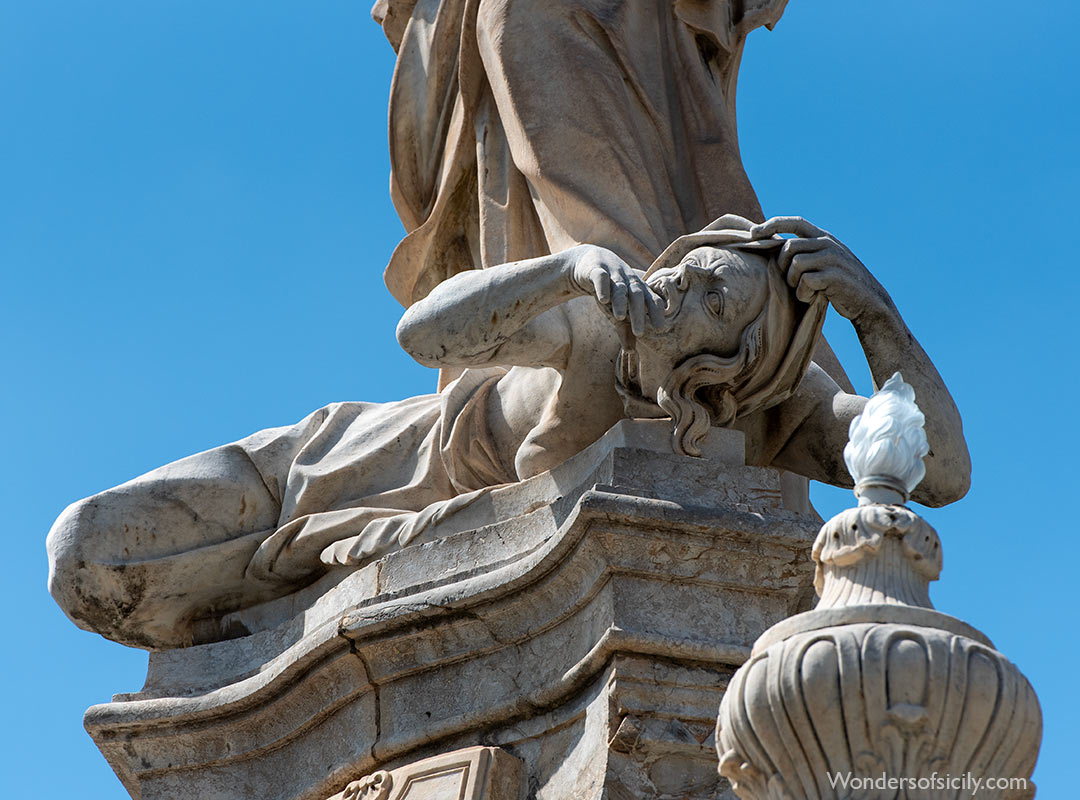
This, I think, symbolically shows the plague being conquered by Rosalia.
Santa Rosalia (1130–1166) is the patron saint of Palermo. Her nickname is la Santuzza (“the Little Saint”).
Born into a Norman noble family, Rosalia embraced a devoutly religious life. She withdrew from the world to live as a hermit in a cave on Mount Pellegrino, where she passed away in solitude in 1166. According to tradition, two angels guided her to the cave, where she inscribed on the wall: “Ego Rosalia Sinibaldi Quisquine et Rosarum domini filia amore Domini mei Iesu Christi in hoc antro habitare decrevi.” (I, Rosalia, daughter of Sinibald, Lord of Monte delle Rose and Quisquina, have resolved to live in this cave for the love of my Lord, Jesus Christ.)
In 1624, during a plague in Palermo, Rosalia is said to have appeared first to a sick woman and later to a hunter. She revealed the location of her remains to the hunter and instructed him to bring her bones to Palermo and have them carried in procession through the city.
The hunter climbed Mount Pellegrino and found her remains as described. He followed her directions, and after her relics were carried around Palermo three times, the plague came to an end. From that moment, Rosalia was venerated as the patron saint of Palermo, and a sanctuary was erected in the cave where her relics were discovered.
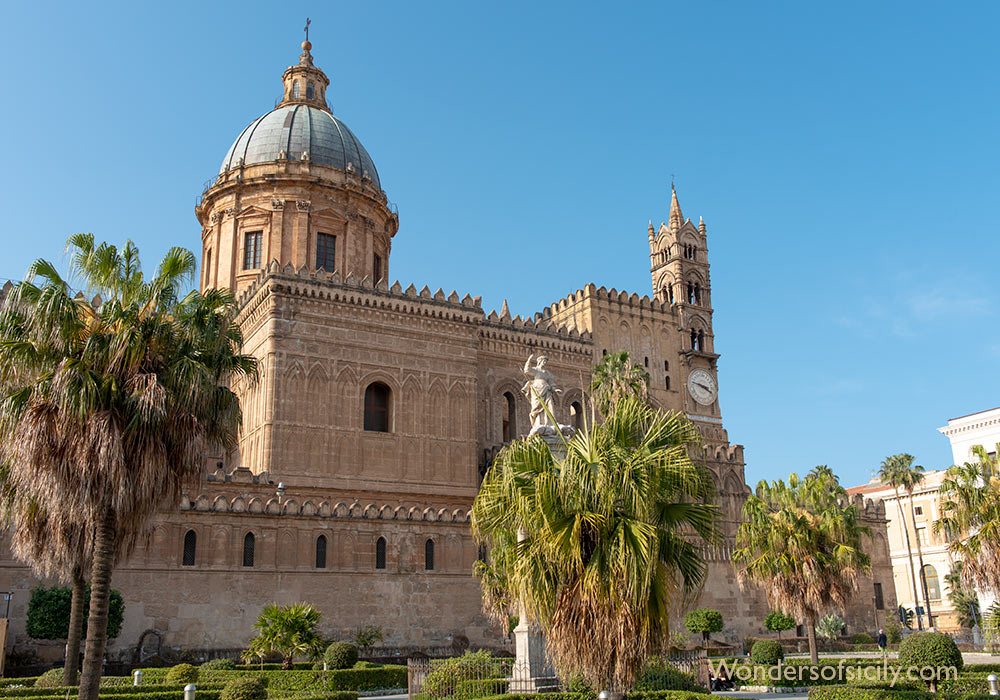
The splendid cathedral. The dome was added by Ferdinando Fuga in 1781–1801.
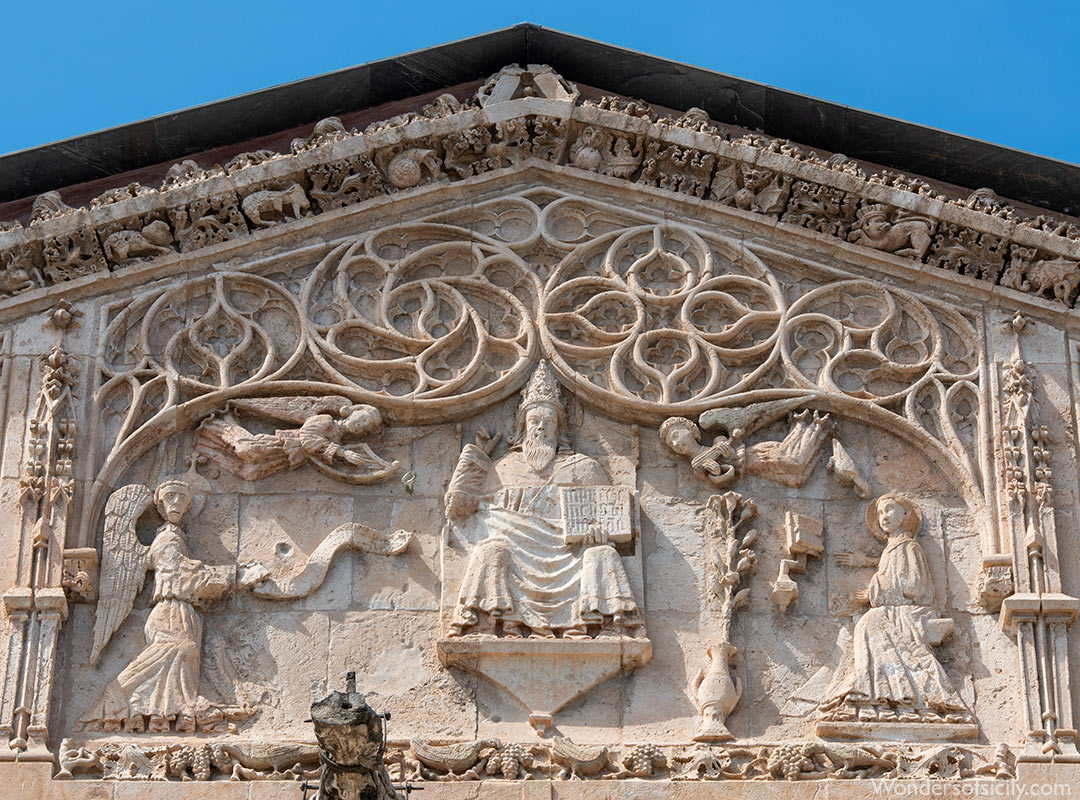
Detail of the cathedral. Look at all the lovely details. Christ Pantocrator is dressed like a Pope, following the desires of the Aragonese kings, usually very close to the papacy.
In 1412, the Kingdom of Sicily was officially united with the Kingdom of Aragon. From this point, Sicily was ruled by the following Aragonese monarchs:
Ferdinand I (1412-1416)
Alfonso the Generous (1416-1458, also known as Alfonso the Magnanimous; he founded the University of Catania in 1434, the first university in Sicily.)
John (1458-1479)
Ferdinand the Catholic (1479-1516). Under Ferdinand the Catholic, who married Isabel of Castile and founded the Kingdom of Spain, Sicily became an integral part of the larger Spanish empire. This effectively marked the end of direct Aragonese rule, as Sicily was now governed as part of the Spanish crown.
The Aragonese rule in Sicily, which lasted for three centuries, had a significant impact on the island's history, culture, and politics. Although their direct rule ended with the incorporation into the Spanish empire, the Aragonese influence continued to shape Sicily's development in the following centuries.
The 15th century in Sicily was defined by rebellions, famine, unrest, and epidemics. In 1492, Ferdinand and Isabella expelled Muslims and Jews from their territories, including Sicily, and established the Inquisition in Palermo.
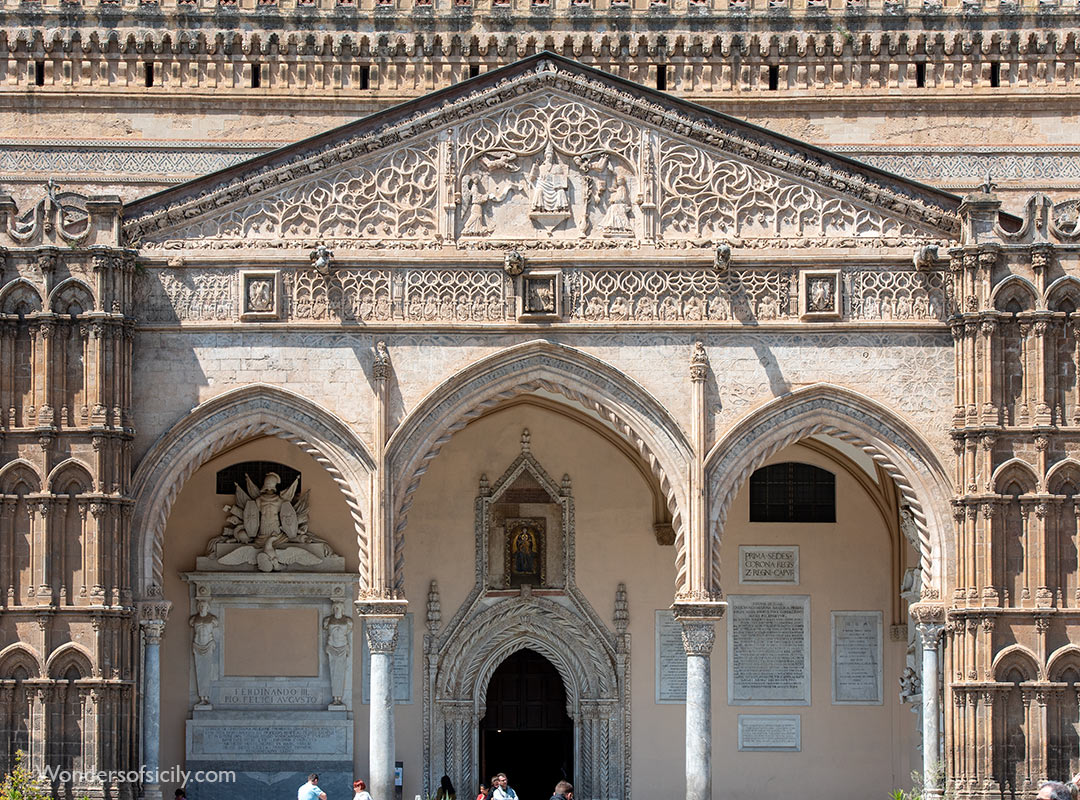
The Catalonian Gothic portico was designed by Antonino Gambara (1453).
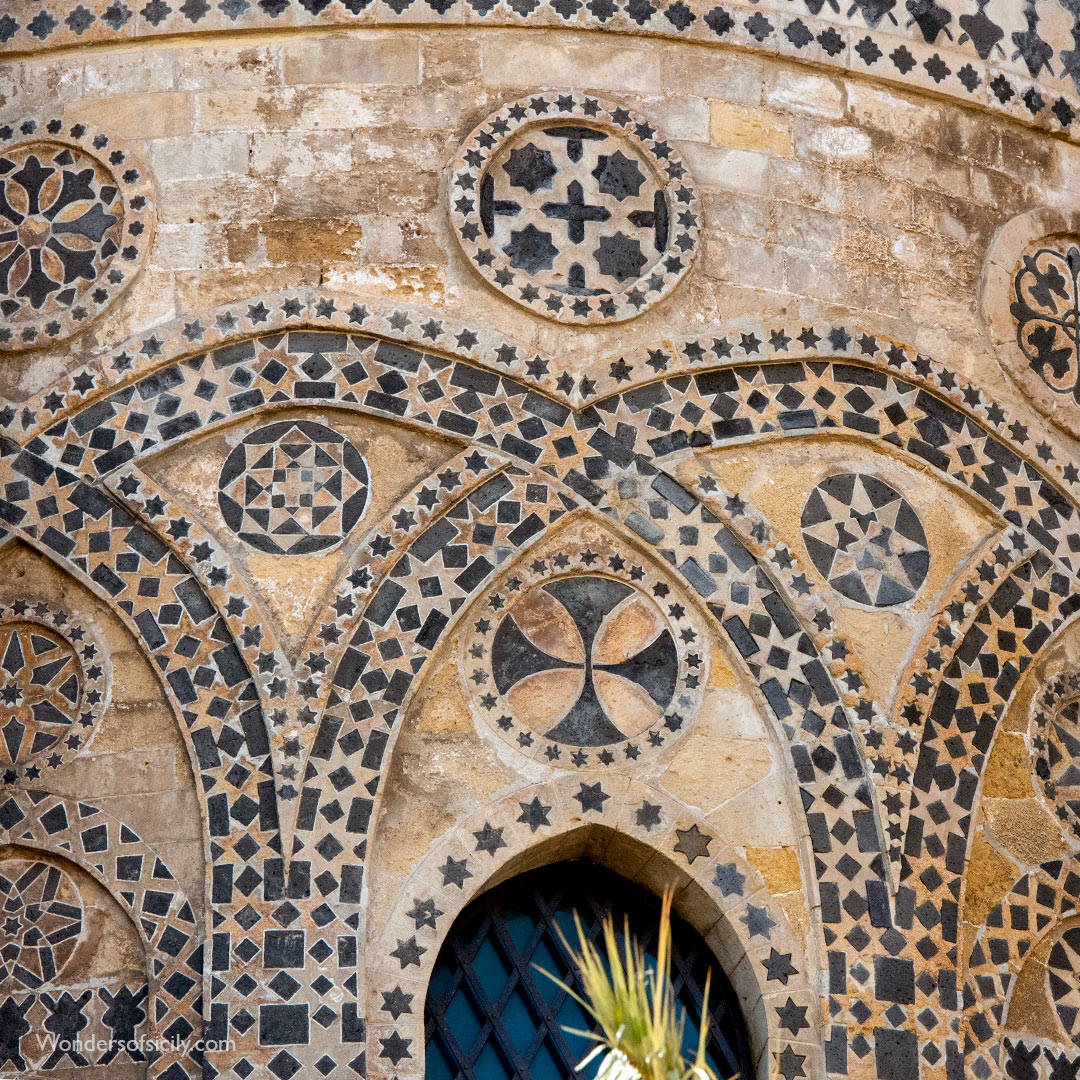
Detail of the facade with a pattern reminiscent of the Monreale Cathedral.
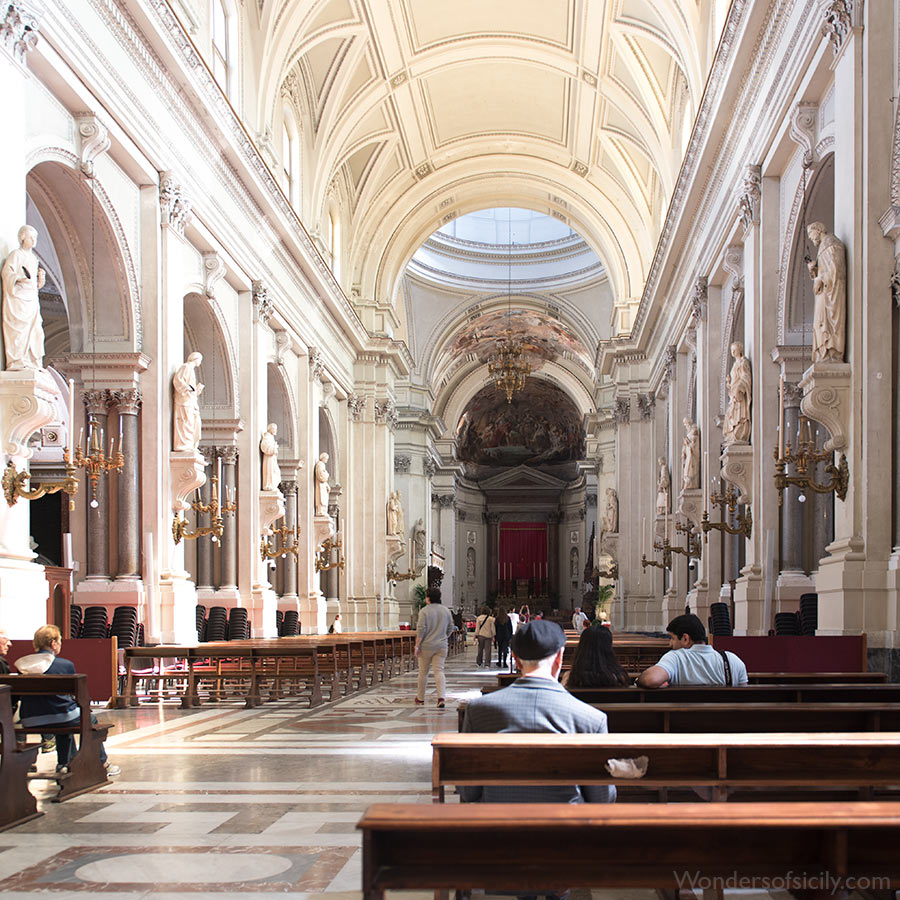
The interior of the cathedral in Palermo is not very exciting compared to the cathedral in Monreale.
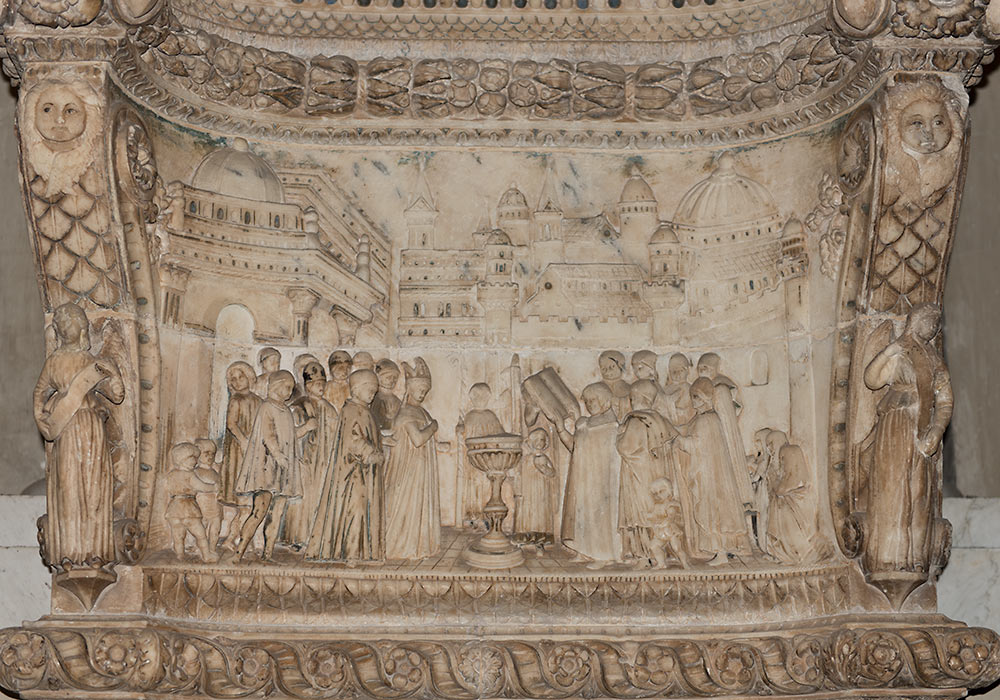
Detail of a (restored) canopied stoup attributed to Domenico Gagini (1420-92).
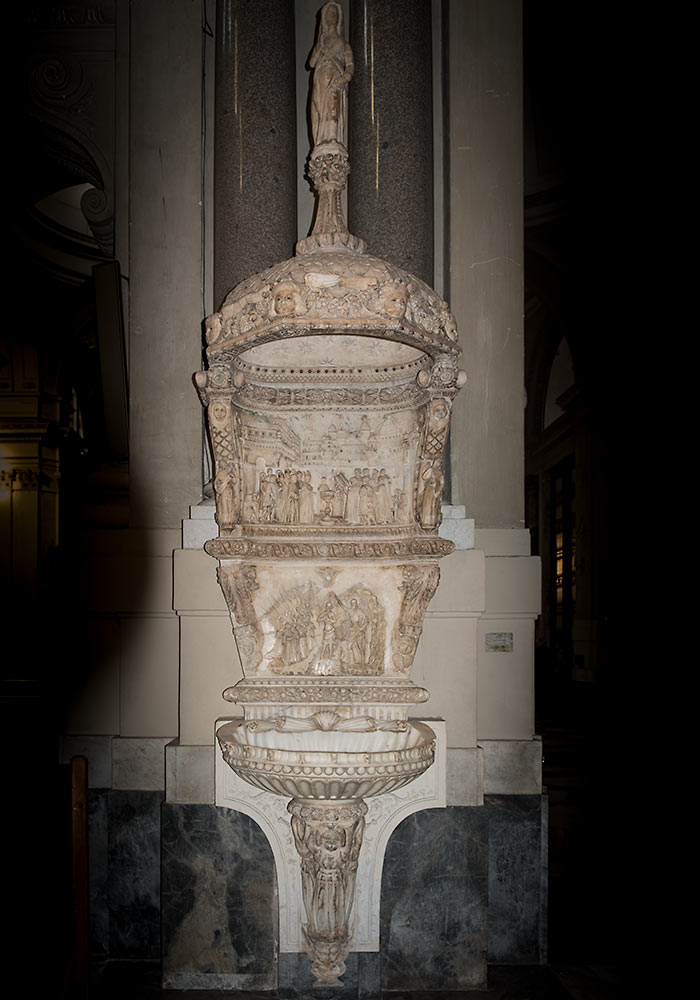
A (restored) 15th century canopied stoup (attributed to Domenico Gagini).
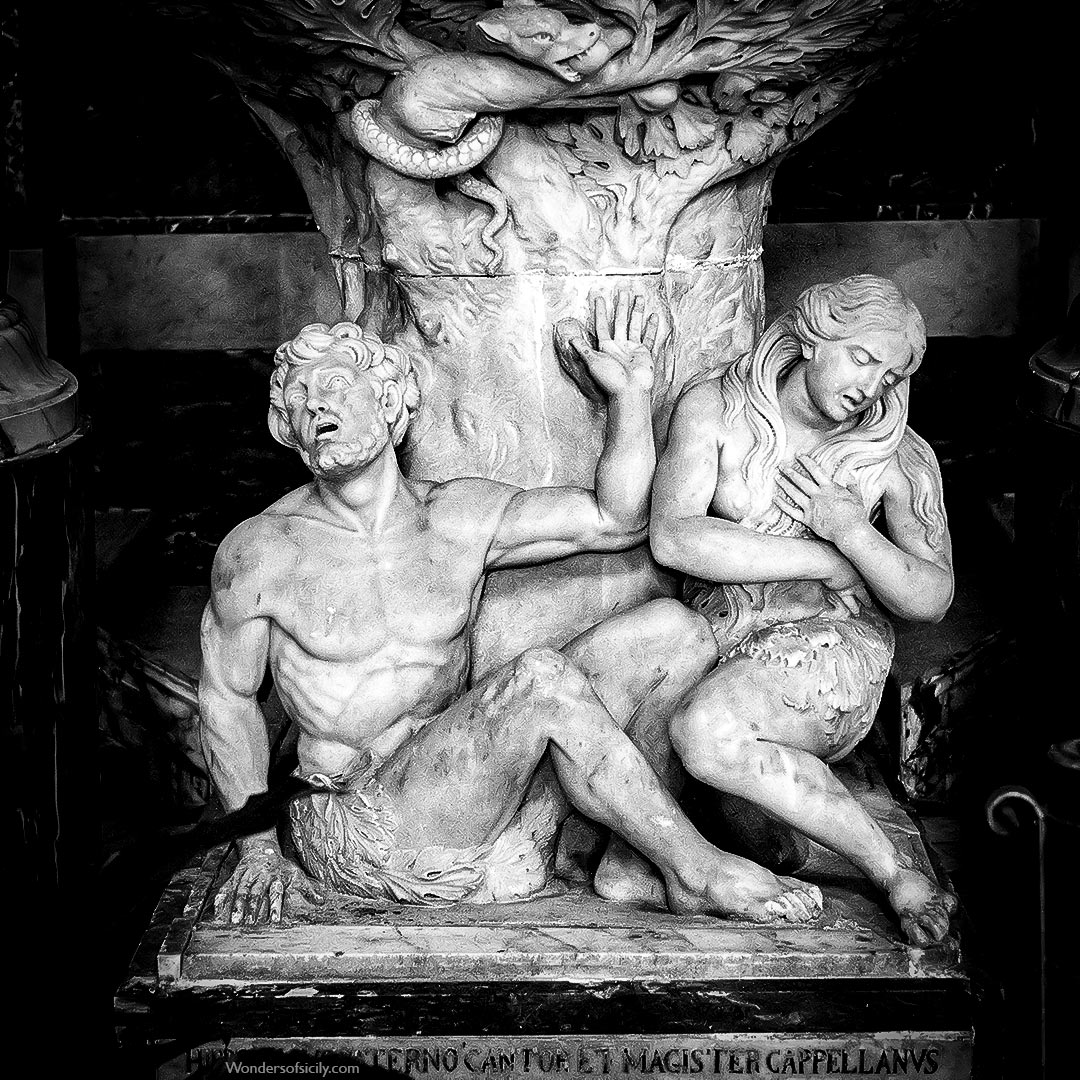
A second font was added in 1797, by Fillipo and Gaetano Pennino. It is supported by sculptures depicting the Tree of Knowledge and Adam and Eve.
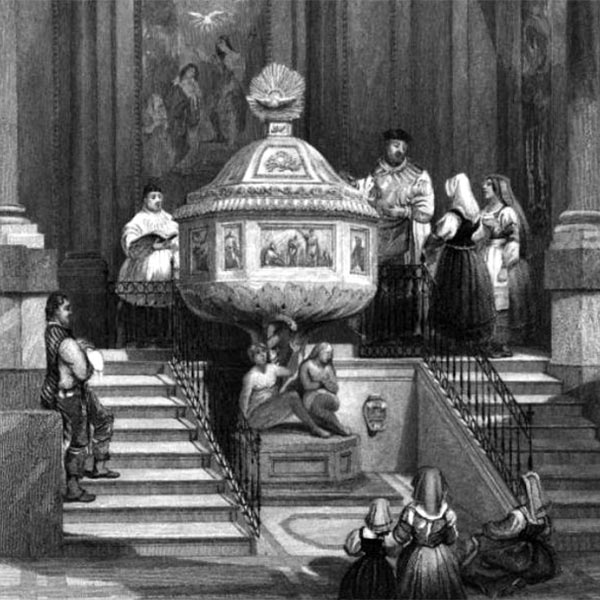
A painting of this font by William Leighton Leitch is the subject of a poetical illustration by Letitia Elizabeth Landon, which was published posthumously in 1840.
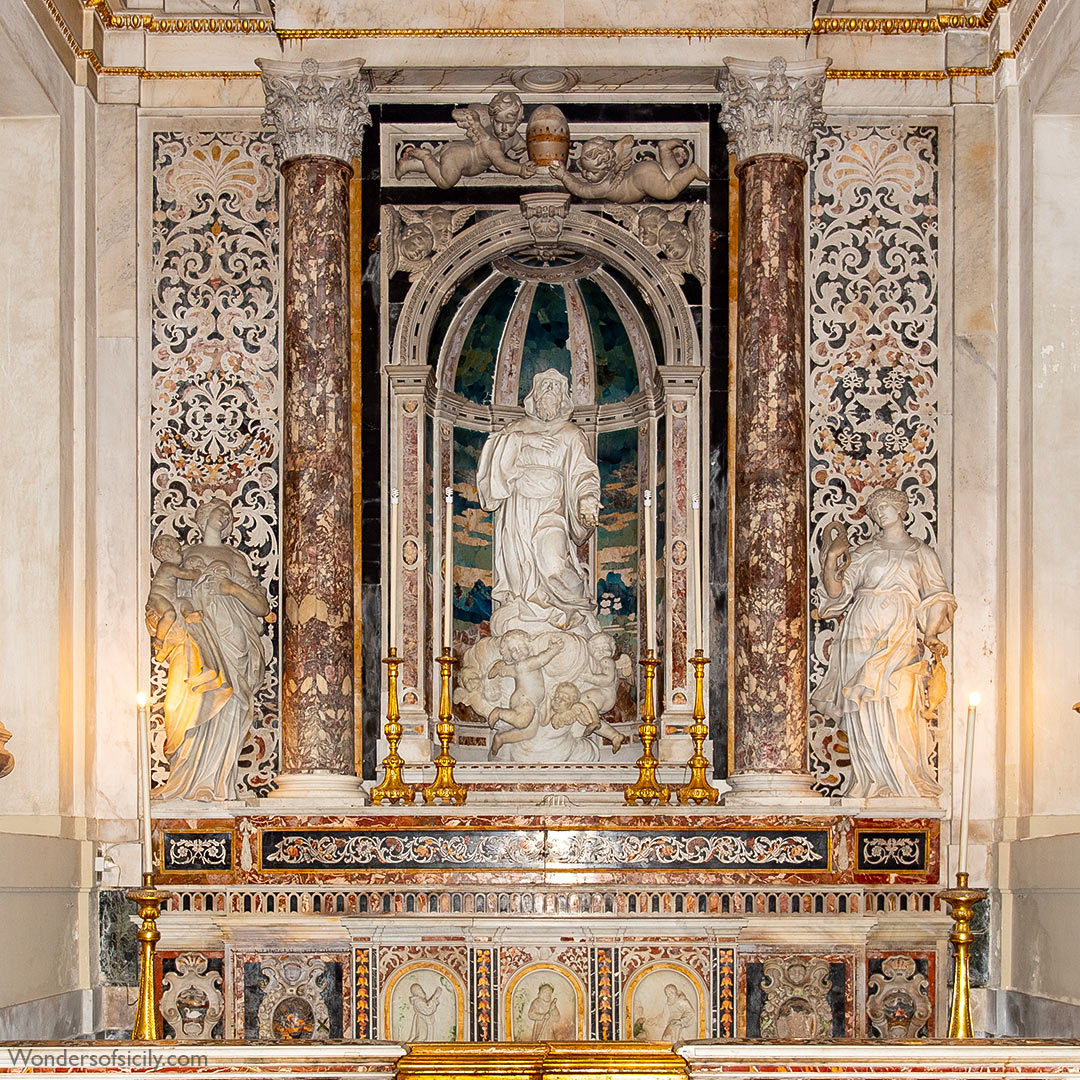
Ove of the side altars.
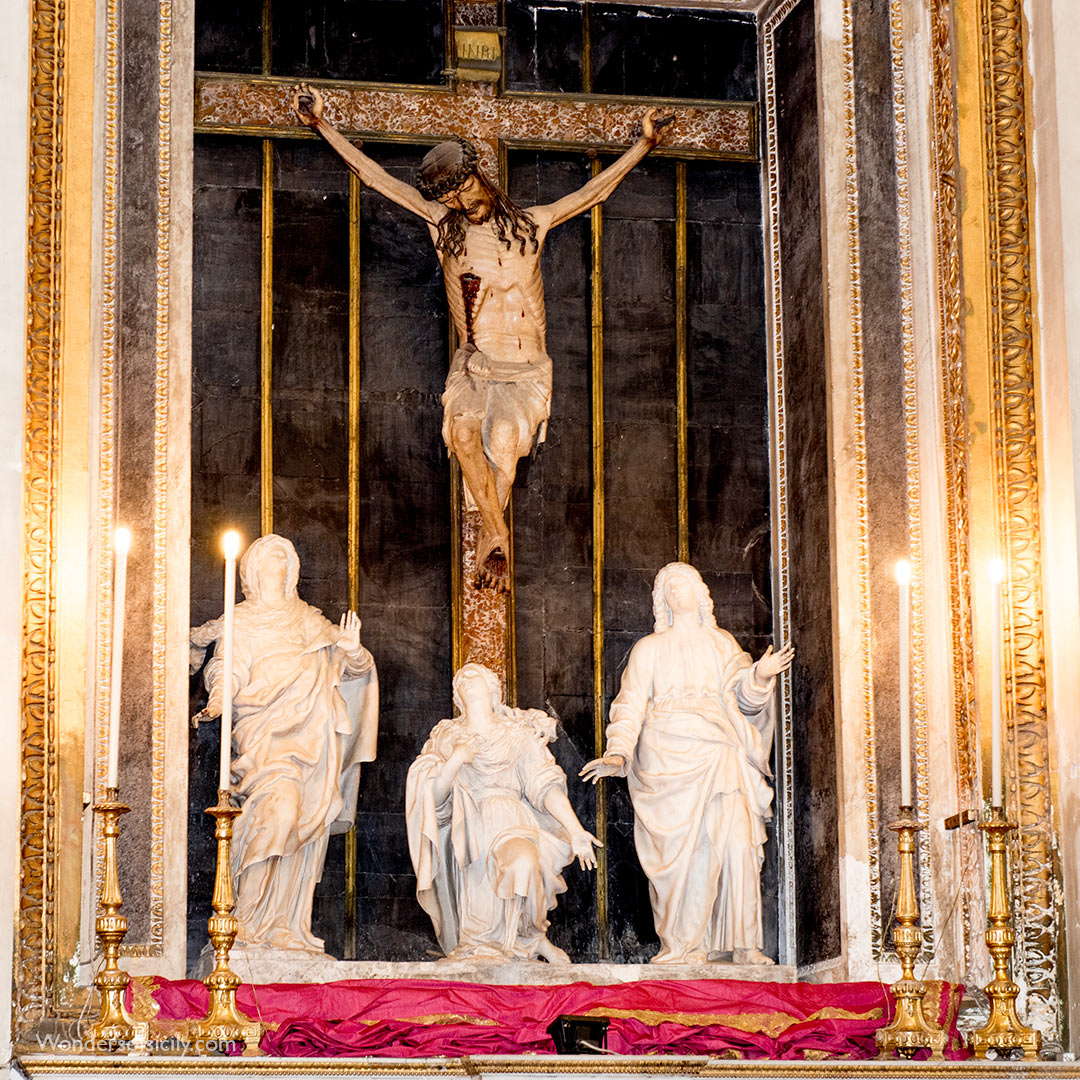
14th-century wooden Crucifix donated by Manfredi Chiaramonte. At its foot are marble statues of mourners made by Gaspare Serpotta and Gaspare Guercio.
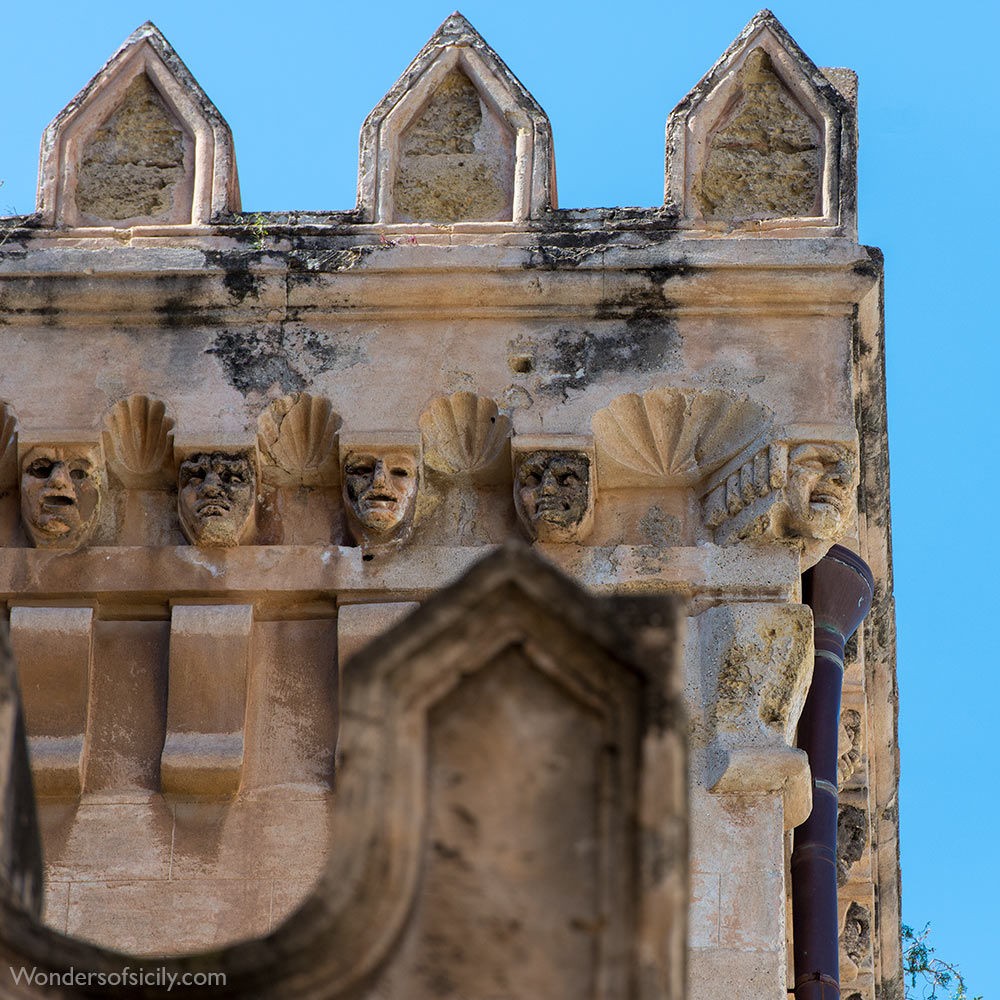
Grotesques, Palermo Cathedral.
UNESCO’s World Heritage List
Arab-Norman Palermo and the Cathedral Churches of Cefalú and Monreale (Italy) - new on the list (2015)
Located on the northern coast of Sicily, Arab-Norman Palermo includes a series of nine civil and religious structures dating from the era of the Norman kingdom of Sicily (1130-1194): two palaces, three churches, a cathedral, a bridge, as well as the cathedrals of Cefalú and Monreale. Collectively, they are an example of a social-cultural syncretism between Western, Islamic and Byzantine cultures on the island which gave rise to new concepts of space, structure and decoration. They also bear testimony to the fruitful coexistence of people of different origins and religions (Muslim, Byzantine, Latin, Jewish, Lombard and French).
Palermo
- Palazzo dei Normanni (The Norman Palace)
- Cappella Palatina (The Palatine Chapel in the Norman Palace)
- Church of San Giovanni degli Eremiti
- Church of Santa Maria dell'Ammiraglio (also known as the Martorana)
- Church of San Cataldo
- Cathedral of Palermo
- The Zisa Palace (La Zisa)
- The Cuba Palace (La Cuba)
Norman Cathedrals
The Exterior of the Palermo Cathedral
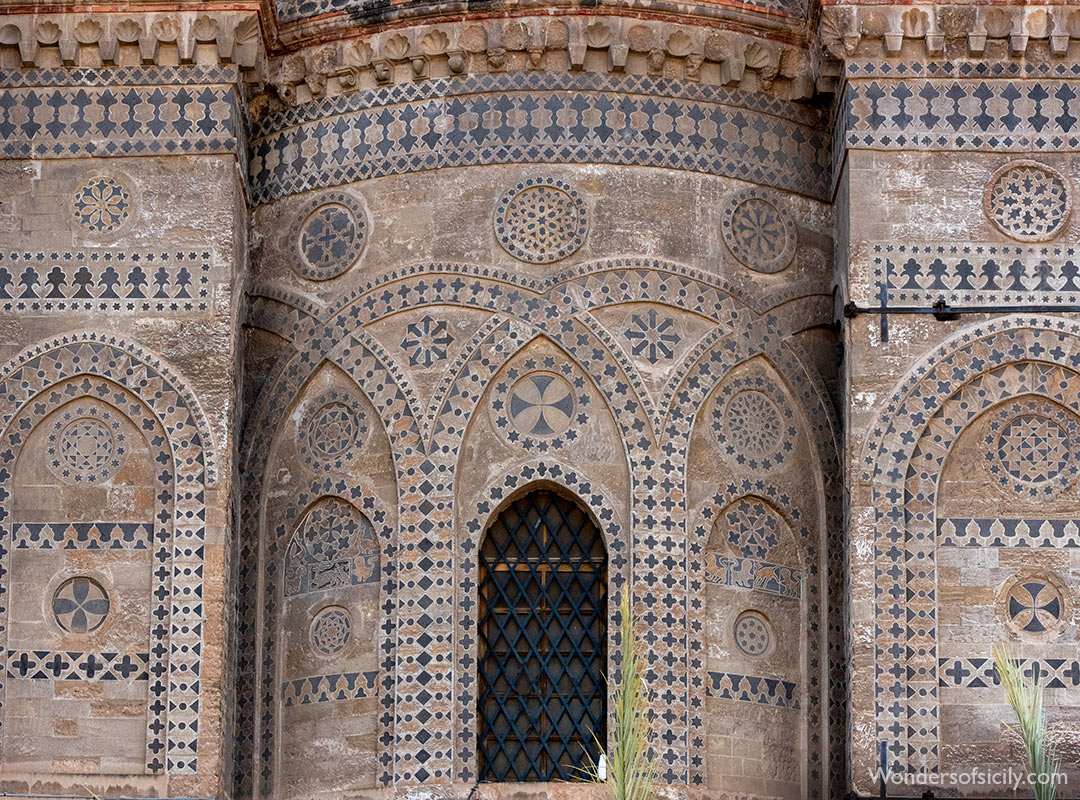
Detail of the magnificent facade.
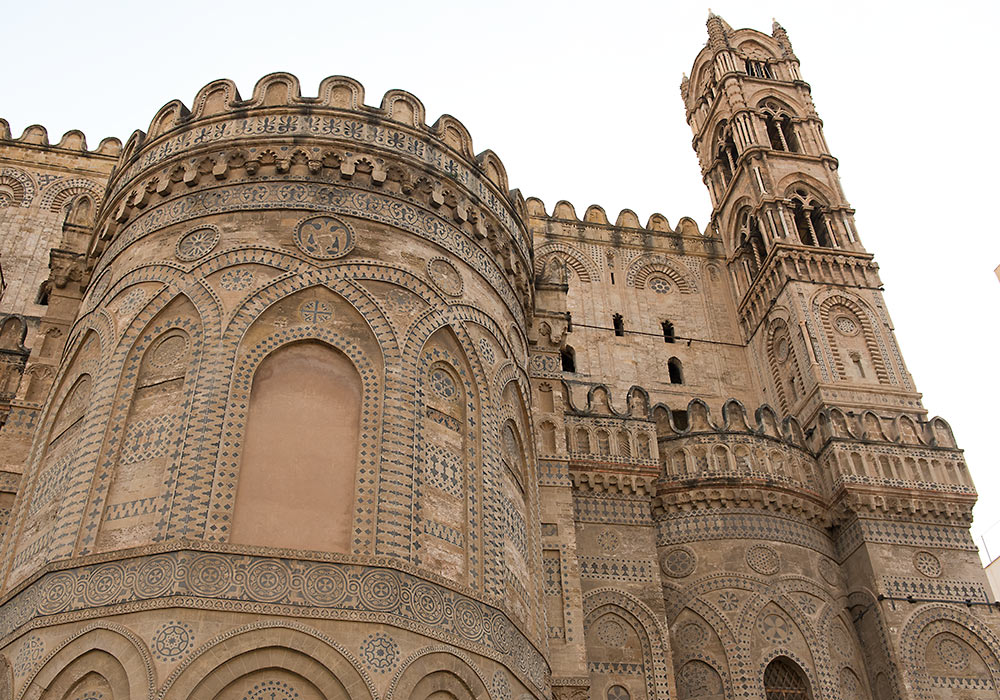
The Cathedral in Palermo was founded in 1185 by Walter of the Mill (Gualtiero Offamiglio), an Englishman who came to Palermo as tutor to the young William II and later became archbishop of Palermo. Walter of the Mill accumulated such a powerful following that the king responded by creating a new city at Monreale.
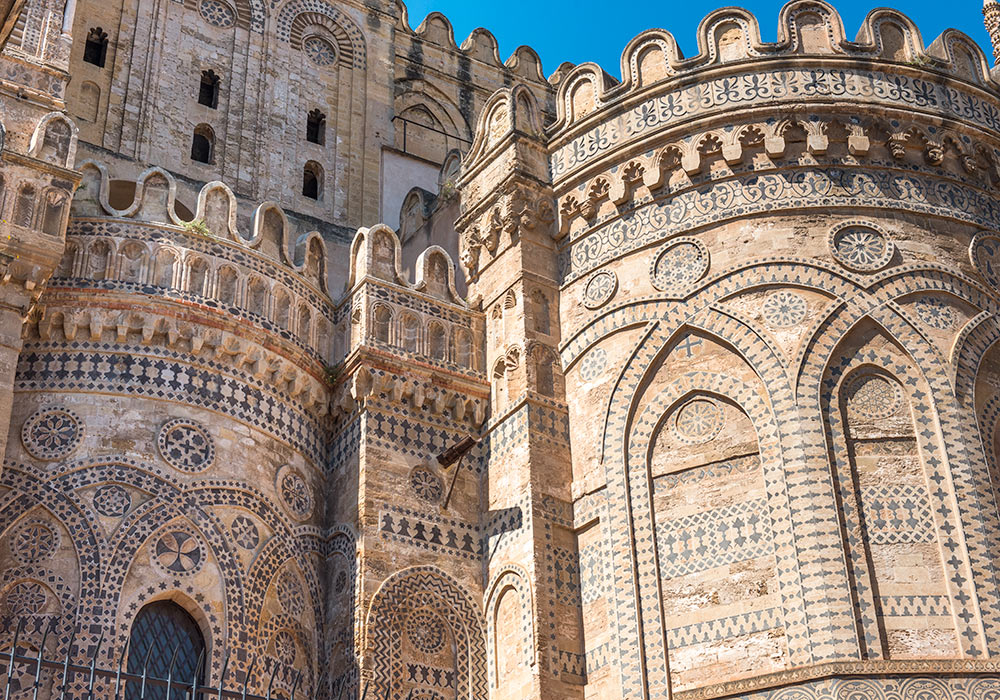
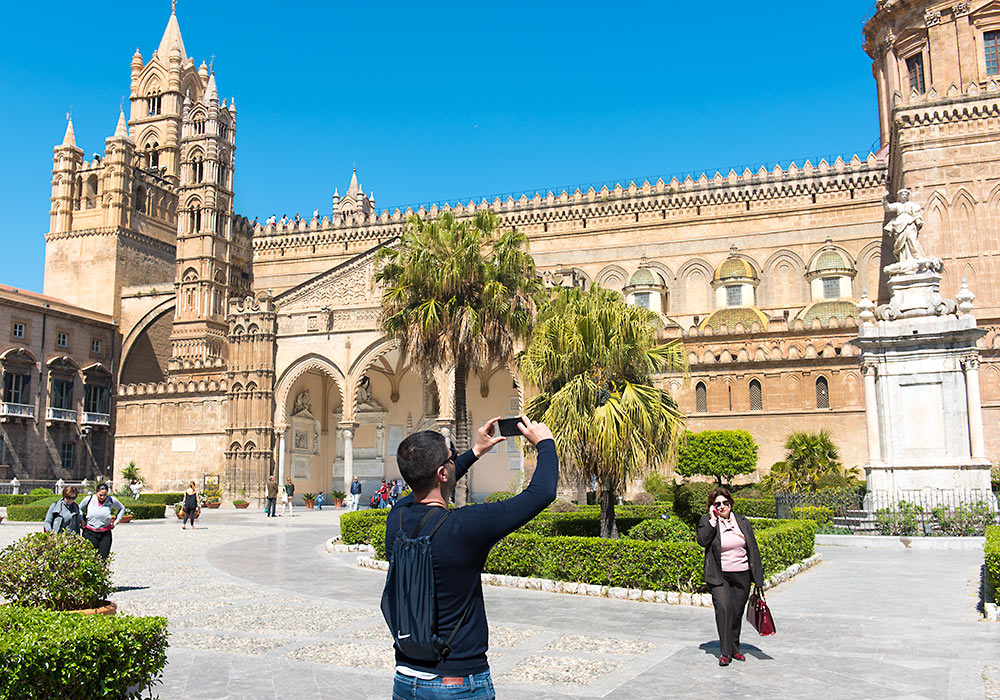
Tourist taking pictures of the cathedral in Palermo (not to be confused with the Monreale cathedral).
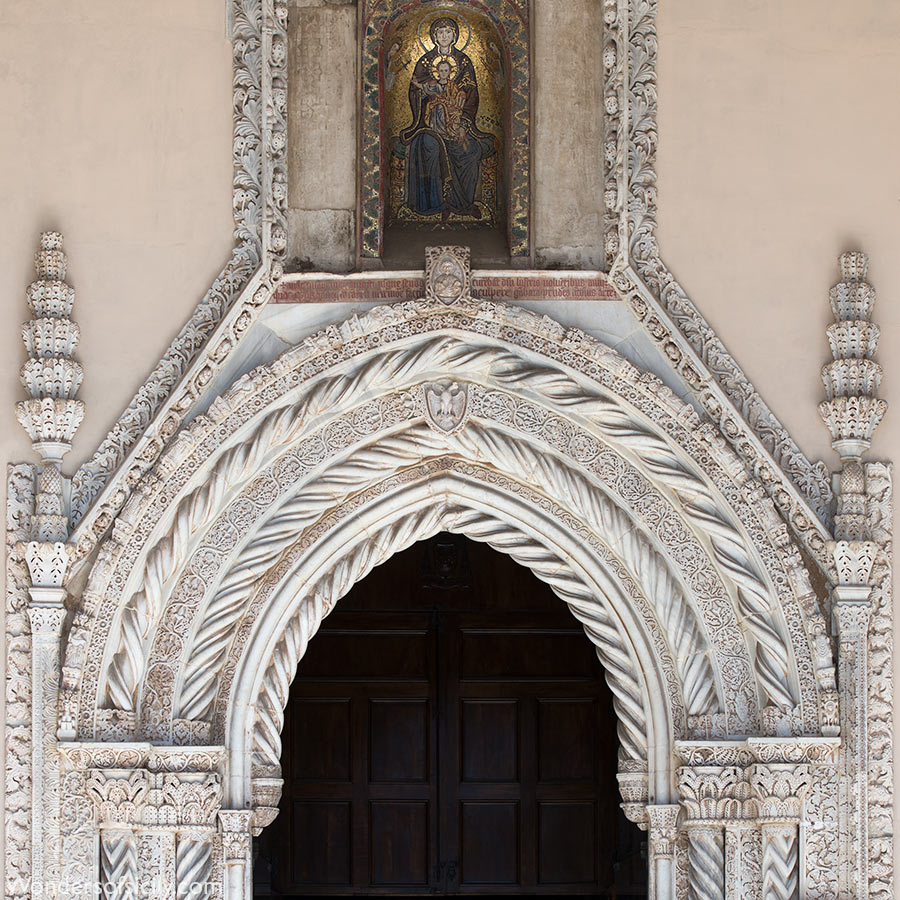
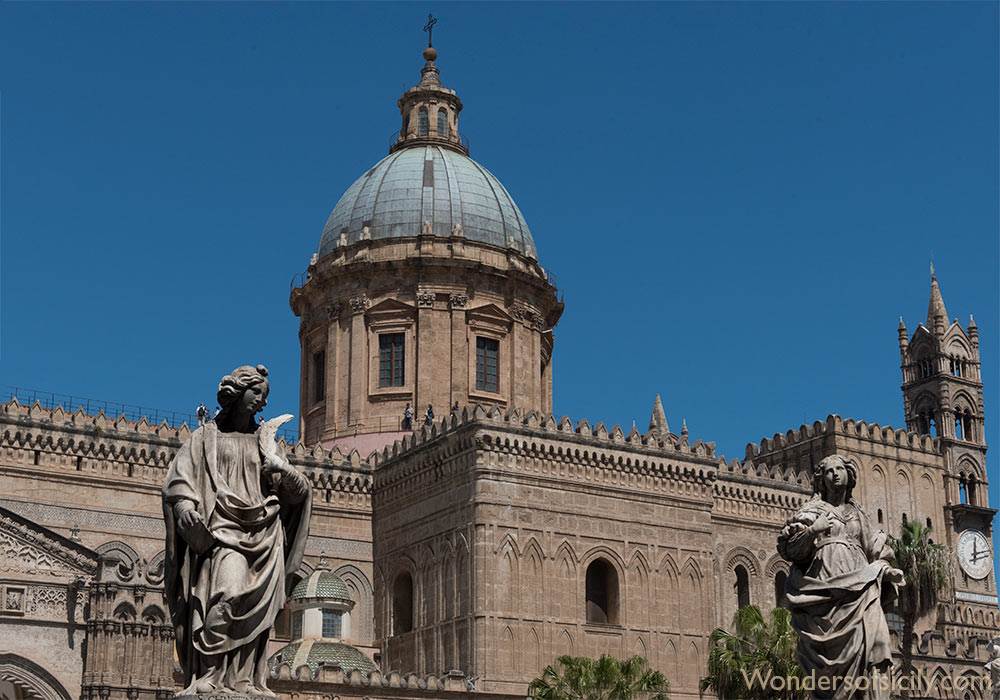
Palermo Cathedral.
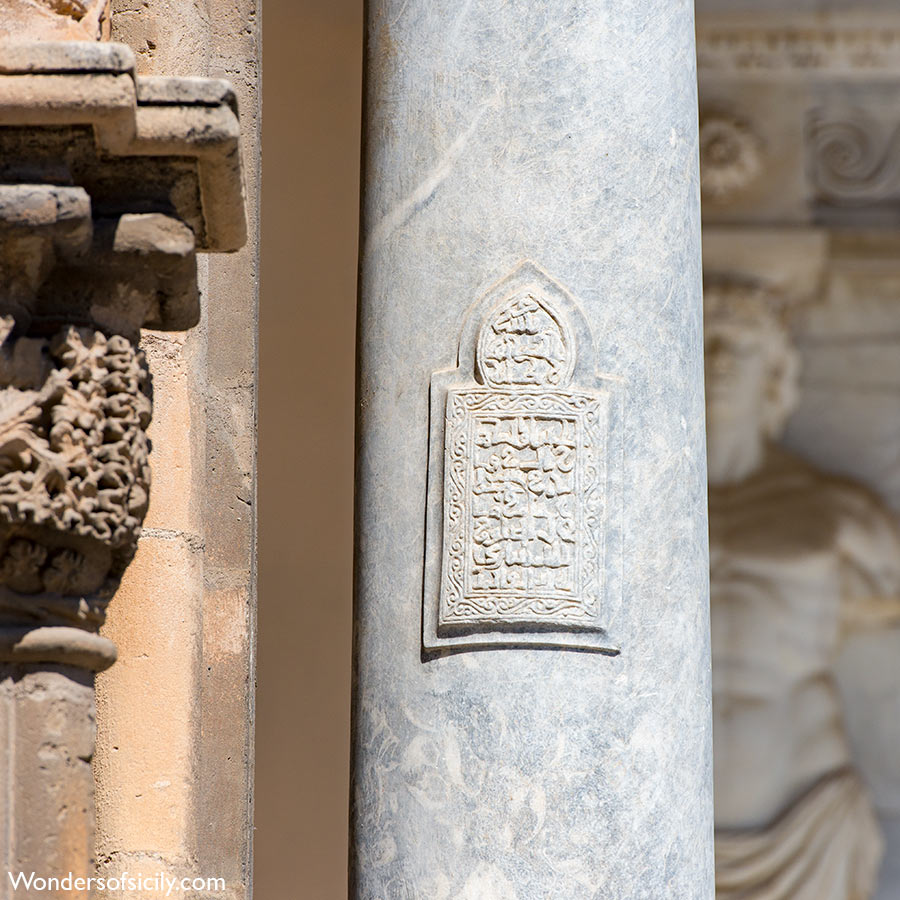
A passage from the Koran is inscribed on the column to the left of the main entrance. It is probably preserved from the earlier mosque that stood here.
Kufic
Kufic script, an early form of Arabic calligraphy that was used to write the Arabic language. It is characterized by the use of straight and angular lines, and is often used to write the Quran (also romanized Koran or Qur'an), the sacred text of Islam. The name “kufic” comes from the city of Kufa, which was an important center of learning and scholarship in the early Islamic world. Kufa is a city in present-day Iraq with c. 110,000 inhabitants. The city is located about 170 kilometers south of Baghdad. It was founded in the 7th century CE, and quickly became an important center of learning and scholarship. Many of the early Islamic scholars, including the famous theologian Abu Hanifa, lived and worked in Kufa. The city is considered to be one of the birthplaces of the Shia branch of Islam (the second-largest branch of Islam), and it remains an important center of Shia scholarship and culture to this day.
Kufic calligraphy is highly respected in the Islamic world and is often used in the design of Islamic architectural elements, such as mosaics, tiles, and inscriptions on buildings. Famous examples in Sicily can be found on a column in La Martorana (Santa Maria dell'Ammiraglio) and on a column outside the cathedral in Palermo.
More on the Arabs in Sicily here…
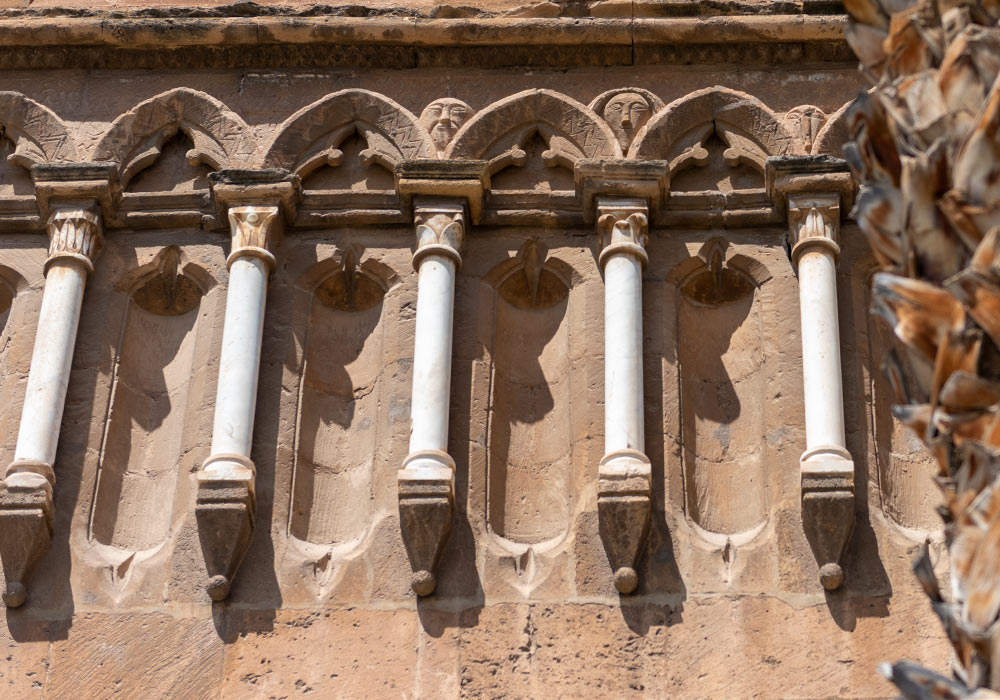
Detail of the facade.
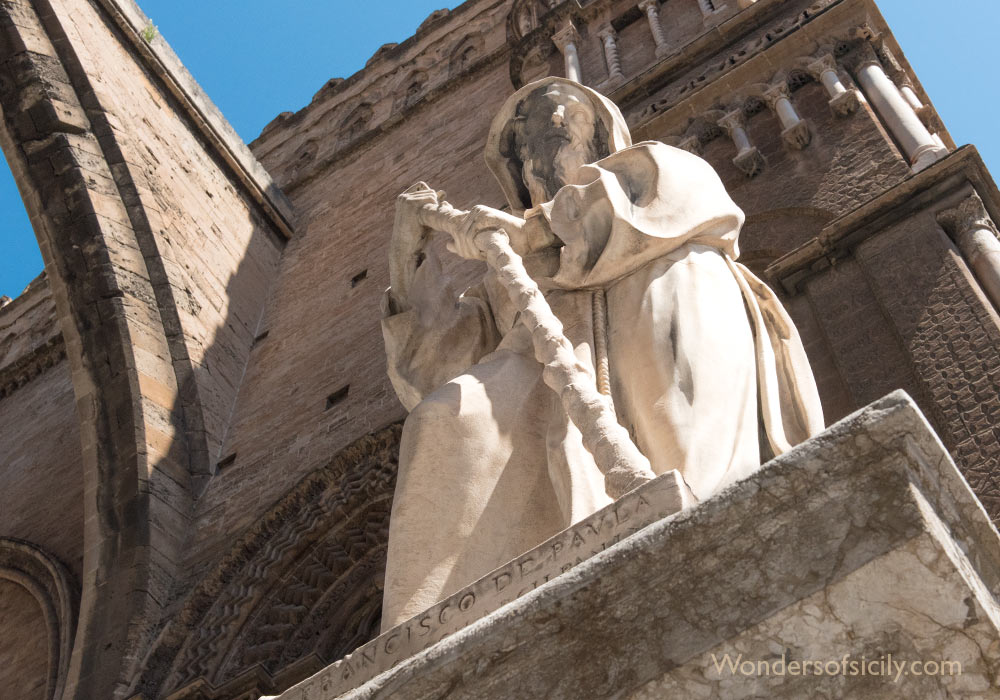
Statue of Saint Francis of Paola (1416–1507) behind the cathedral in Palermo.
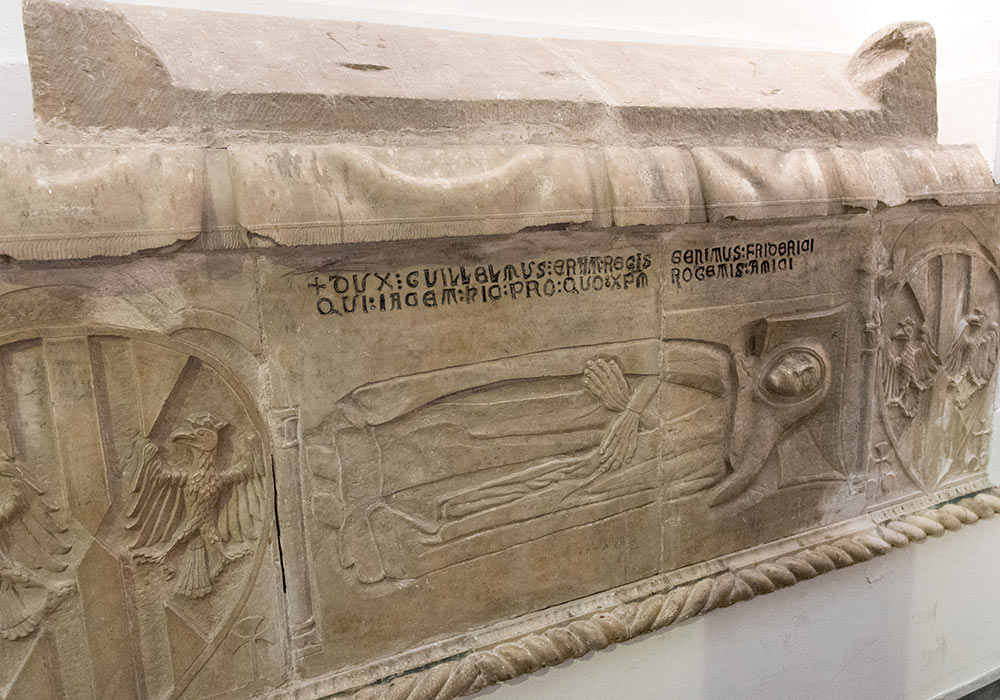
William II, Duke of Athens’ tomb in the Palermo cathedral.
William II, Duke of Athens (d. 22 August 1338), son of Frederick II of Aragon. In 1337, his father willed him the Principality of Taranto, the county of Calatafimi, the honour of Monte Sant'Angelo, and various castles and lands in Noto, Spaccaforno, Capo Passero, and Avola when his mother, Eleanor, daughter of Charles II of Naples, died. She died in 1341, but William died first on 22 August 1338. He left his library to the Dominicans of Palermo.
The Creepy Crypt in the Palermo Cathedral
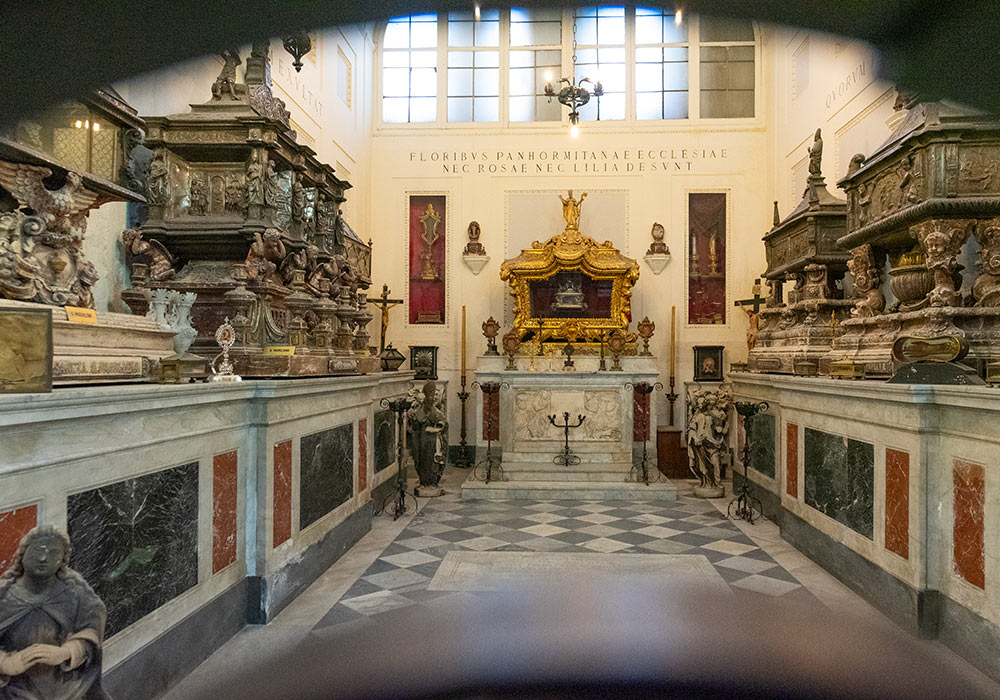
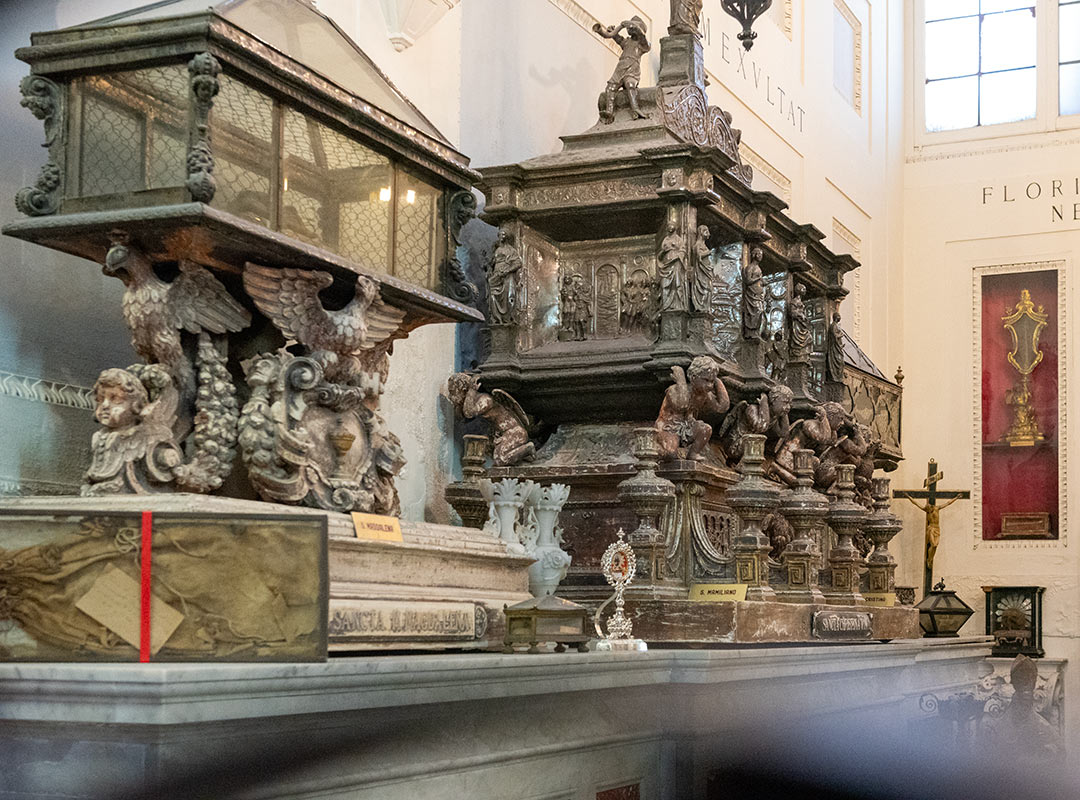
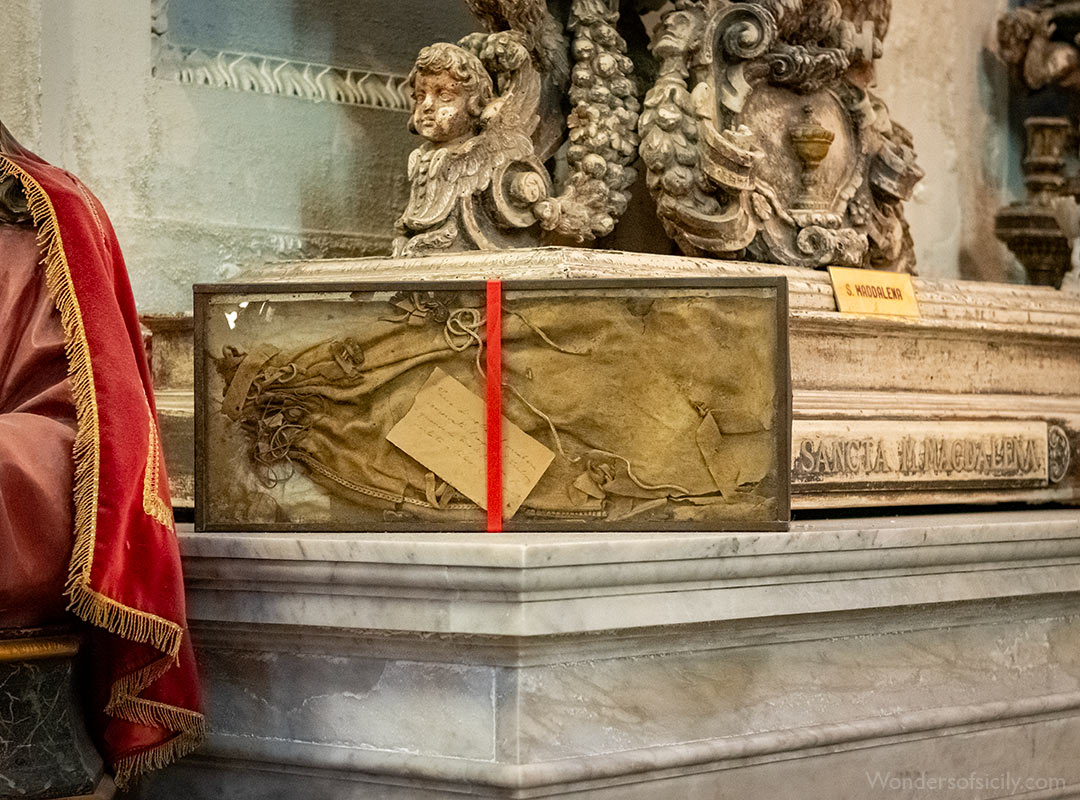
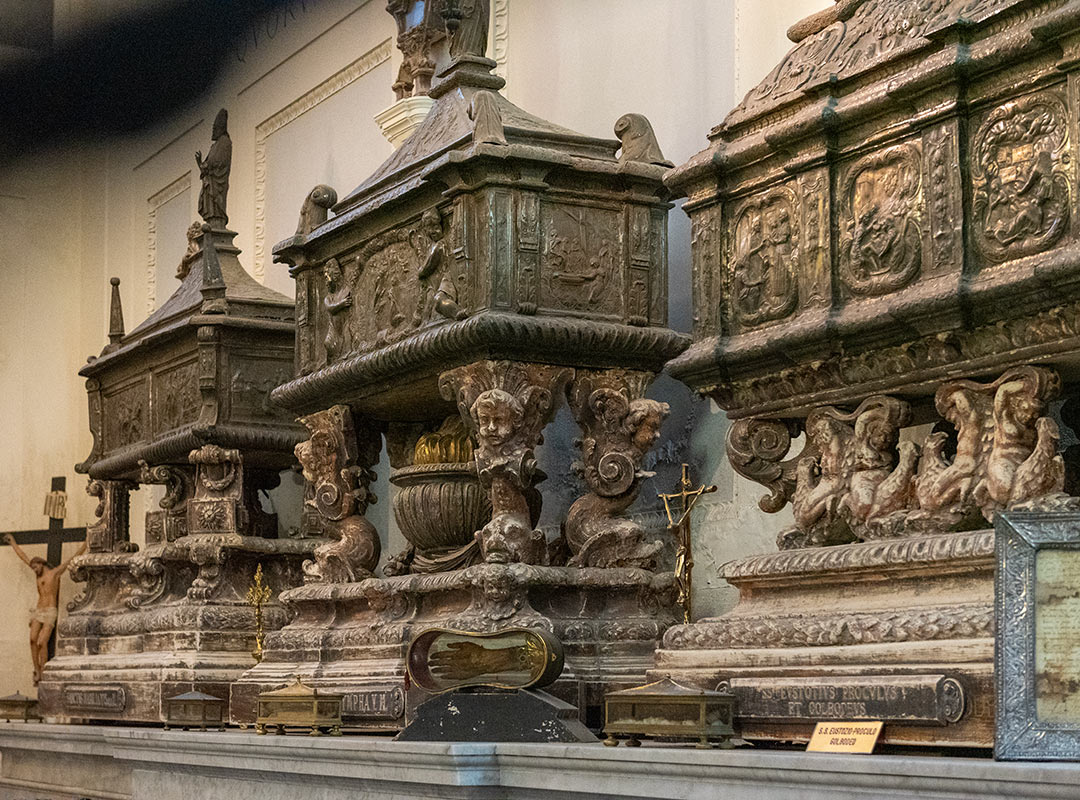
Seminario Arcivescovile di Palermo "San Mamiliano"
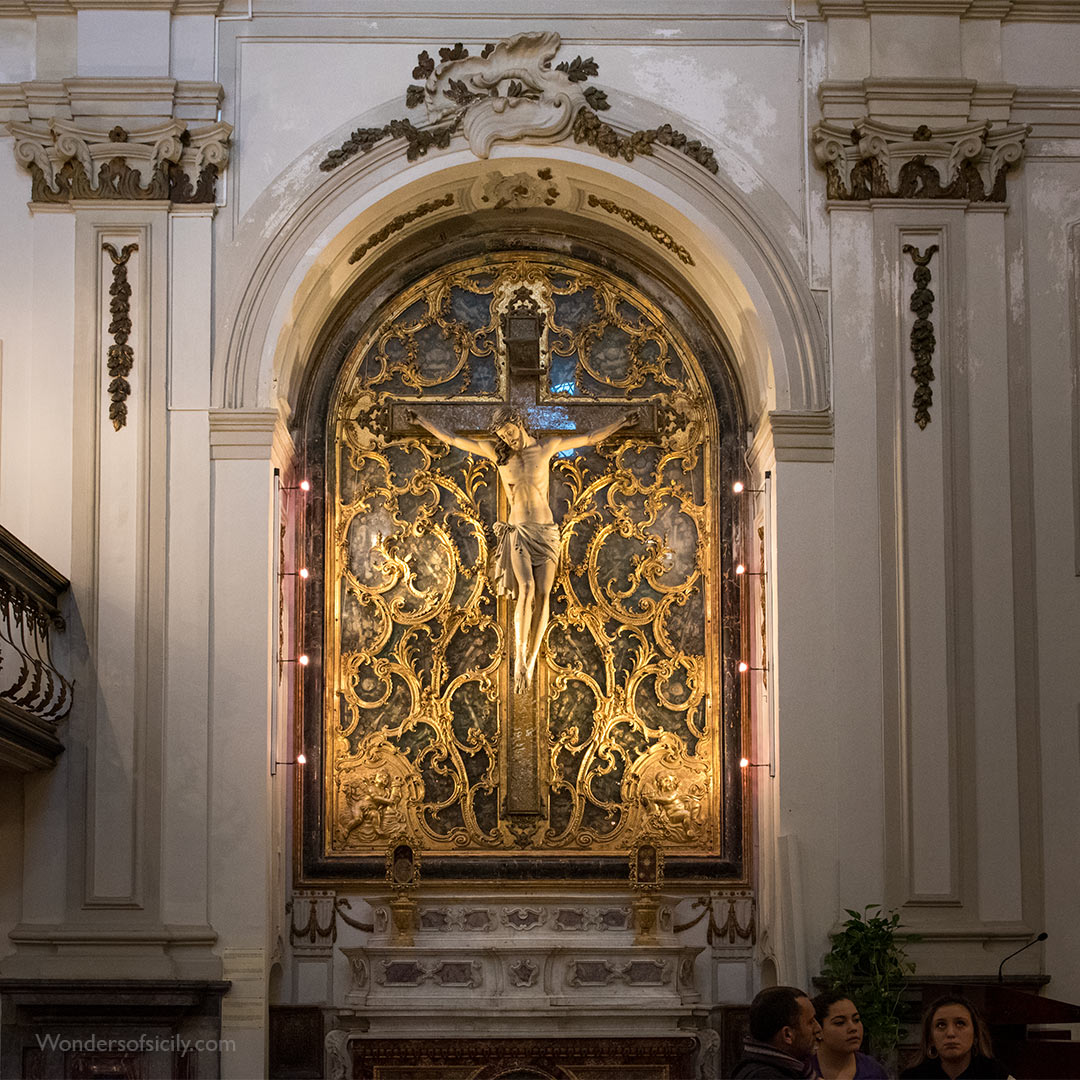
Crucifix with relics (crocifisso reliquiario) in a building behind the cathedral now used as a school for priests, Seminario Arcivescovile di Palermo "San Mamiliano" (community that trains candidates for the priestly ministry of the dioceses of Palermo, Mazara del Vallo, Piana degli Albanesi, and Trapani). The building is in Via Incoronazione, next to Palazzo Artale Tumminello, and is normally closed. It was open for tourists during a school project for children.
https://www.seminario.arcidiocesi.palermo.it/monastero-e-chiesa/
A special thanks to Attilio Lenzi for invaluable help and for providing insightful information!

